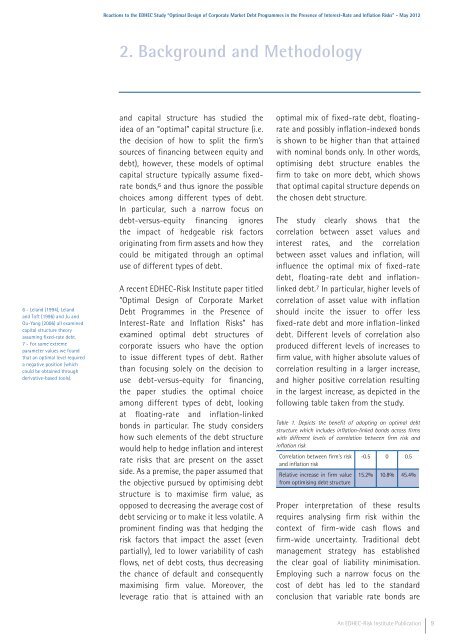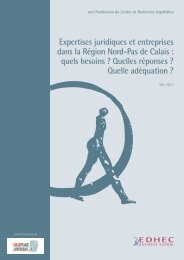<strong>Reactions</strong> <strong>to</strong> <strong>the</strong> <strong>EDHEC</strong> <strong>Study</strong> “Optimal Design of Corporate Market Debt Programmes in <strong>the</strong> Presence of Interest-Rate <strong>and</strong> Inflation Risks” - May 20122. Background <strong>and</strong> Methodology1 - Each of <strong>the</strong>se methodshas unique risks <strong>and</strong>drawbacks, <strong>and</strong> <strong>the</strong>re isgenerally a trade-off betweenaccuracy <strong>and</strong> cost. Forexample, inflation swaps(ignoring counterparty risk)are a direct hedge, however,<strong>the</strong>y may be prohibitivelycostly. TIPS similarly havelow returns. Ang et al. (2011)have studied <strong>the</strong> relationshipbetween specific s<strong>to</strong>cks <strong>and</strong>inflation, while o<strong>the</strong>rs havefound that, generally, equitiesare negatively correlated withinflation in <strong>the</strong> short-term,but positively correlatedover longer horizons. Thus,equities, as well as real estate<strong>and</strong> commodities have beenidentified as inflation hedges,albeit imperfect ones (see e.g.Amenc et al. 2009).2 - For example, in March2012, US TIPS were sold withrecord negative yields (seee.g. Eddings 2012).3 - Strong inves<strong>to</strong>r dem<strong>and</strong>for inflation-linked corporatebonds is reflected in <strong>the</strong>“sell-out” of Tesco’s recentlyissued (Dec. 2011) inflationlinkedbond offering (seeHyde 2011).4 - See e.g. Inderst (2010)who finds that infrastructurecompanies, as well as utilities(which sometimes haveregulated price increases tied<strong>to</strong> inflation indices) haveinflation-linked cash flows.5 - As mentioned, utility <strong>and</strong>infrastructure companieshave been known <strong>to</strong> haverevenues strongly correlated<strong>to</strong> inflation, while, forexample, o<strong>the</strong>rs have noted anegative correlation betweeninflation <strong>and</strong> <strong>the</strong> revenuesof banking companies(which hold high amounts offinancial assets; see Boydet al. 2001).2.1. Background: The case forinflation-linked corporate bondsInflation risk has been a growing concernfor all inves<strong>to</strong>rs while for some, suchas pension funds which have liabilitiesdirectly tied <strong>to</strong> an inflation index, inflationhedging has always been of criticalimportance. The assets used by inves<strong>to</strong>rs<strong>to</strong> hedge inflation risk typically includesovereign inflation-linked bonds, such asU.S. Treasury Inflation Protected Securities(TIPS), inflation swaps, equities, <strong>and</strong>commodities. 1 Sovereign bonds tied <strong>to</strong> aninflation index, however, have lost some of<strong>the</strong>ir appeal <strong>to</strong> inves<strong>to</strong>rs. In particular, <strong>the</strong>low returns of <strong>the</strong>se bonds 2 coupled withrising uncertainty of sovereign issuers’credit-worthiness have contributed <strong>to</strong>an environment where inflation-linkedbonds issued by corporations may emergeas an appropriate substitute for sovereigninflation-linked bonds. 3Many institutional inves<strong>to</strong>rs, while <strong>the</strong>yoften have fixed liabilities, are free <strong>to</strong>choose in terms of defining <strong>the</strong>ir assetallocation. Conversely, <strong>the</strong> assets ofcorporations which issue bonds forfinancing are relatively fixed, while<strong>the</strong>y have <strong>the</strong> opportunity <strong>to</strong> adjust<strong>the</strong>ir liabilities through various formsof debt-issuances, including inflationlinkedbonds which are typically tied <strong>to</strong>an inflation index such as <strong>the</strong> CPI, <strong>and</strong>floating rate bonds which are tied <strong>to</strong><strong>the</strong> evolving level of interest rates. Firmswith high correlation between <strong>the</strong>ir cashflows <strong>and</strong> inflation can effectively hedge<strong>the</strong> inflation risk inherent in <strong>the</strong>ir cashflows by issuing inflation-linked debt. Forexample, it is often argued that firms in<strong>the</strong> utility sec<strong>to</strong>r 4 have revenues whichincrease with inflation, thus offeringnatural compensation for an obligation<strong>to</strong> pay inflation-linked coupons on bondsissued. This same type of debt can beused by inves<strong>to</strong>rs <strong>to</strong> hedge inflationbasedliabilities. Fur<strong>the</strong>rmore, corporatebonds share a credit risk component withcorporate liabilities (particularly pensionliabilities), making <strong>the</strong>m a more naturalliability hedge than sovereign bonds(Scherer 2006). Thus inflation-linkedcorporate bonds potentially provide ameans <strong>to</strong> reduce <strong>the</strong> risk of certain issuerswhile simultaneously reducing <strong>the</strong> risk ofinves<strong>to</strong>rs.Despite <strong>the</strong> fact that levels of correlationof corporate cash flows with inflationvary widely across companies, 5 corporatedebt issuances are nearly uniform in <strong>the</strong>irtreatment of inflation risk – with most of<strong>the</strong>m refraining from issuing inflationlinkeddebt. As a consequence, <strong>the</strong> marketfor inflation-linked corporate debt is notwell developed. For <strong>the</strong> UK, Leaviss (2010)estimates <strong>the</strong> outst<strong>and</strong>ing amount ofinflation-linked corporate debt at $11billion, compared <strong>to</strong> a <strong>to</strong>tal market of$342 billion for corporate bonds. Ano<strong>the</strong>rillustration of <strong>the</strong> scarcity of inflationlinkedcorporate bonds is that amongst<strong>the</strong> 94 corporate bonds available from <strong>the</strong>retail bonds outlet of <strong>the</strong> London S<strong>to</strong>ckExchange, <strong>the</strong>re are only two inflationlinkedbonds.The lack of development of <strong>the</strong> corporateinflation-linked debt market in practice,has a parallel in <strong>the</strong> academic literaturewhich has relatively little <strong>to</strong> say on how<strong>to</strong> optimally choose – as an issuer –between different types of debt (e.g.inflation-linked versus nominal debt). Theacademic literature on debt-management8 An <strong>EDHEC</strong>-Risk Institute Publication
<strong>Reactions</strong> <strong>to</strong> <strong>the</strong> <strong>EDHEC</strong> <strong>Study</strong> “Optimal Design of Corporate Market Debt Programmes in <strong>the</strong> Presence of Interest-Rate <strong>and</strong> Inflation Risks” - May 20122. Background <strong>and</strong> Methodology6 - Lel<strong>and</strong> (1994), Lel<strong>and</strong><strong>and</strong> Toft (1996) <strong>and</strong> Ju <strong>and</strong>Ou-Yang (2006) all examinedcapital structure <strong>the</strong>oryassuming fixed-rate debt.7 - For some extremeparameter values we foundthat an optimal level requireda negative position (whichcould be obtained throughderivative-based <strong>to</strong>ols).<strong>and</strong> capital structure has studied <strong>the</strong>idea of an “optimal” capital structure (i.e.<strong>the</strong> decision of how <strong>to</strong> split <strong>the</strong> firm’ssources of financing between equity <strong>and</strong>debt), however, <strong>the</strong>se models of optimalcapital structure typically assume fixedratebonds, 6 <strong>and</strong> thus ignore <strong>the</strong> possiblechoices among different types of debt.In particular, such a narrow focus ondebt-versus-equity financing ignores<strong>the</strong> impact of hedgeable risk fac<strong>to</strong>rsoriginating from firm assets <strong>and</strong> how <strong>the</strong>ycould be mitigated through an optimaluse of different types of debt.A recent <strong>EDHEC</strong>-Risk Institute paper titled“Optimal Design of Corporate MarketDebt Programmes in <strong>the</strong> Presence ofInterest-Rate <strong>and</strong> Inflation Risks” hasexamined optimal debt structures ofcorporate issuers who have <strong>the</strong> option<strong>to</strong> issue different types of debt. Ra<strong>the</strong>rthan focusing solely on <strong>the</strong> decision <strong>to</strong>use debt-versus-equity for financing,<strong>the</strong> paper studies <strong>the</strong> optimal choiceamong different types of debt, lookingat floating-rate <strong>and</strong> inflation-linkedbonds in particular. The study considershow such elements of <strong>the</strong> debt structurewould help <strong>to</strong> hedge inflation <strong>and</strong> interestrate risks that are present on <strong>the</strong> assetside. As a premise, <strong>the</strong> paper assumed that<strong>the</strong> objective pursued by optimising debtstructure is <strong>to</strong> maximise firm value, asopposed <strong>to</strong> decreasing <strong>the</strong> average cost ofdebt servicing or <strong>to</strong> make it less volatile. Aprominent finding was that hedging <strong>the</strong>risk fac<strong>to</strong>rs that impact <strong>the</strong> asset (evenpartially), led <strong>to</strong> lower variability of cashflows, net of debt costs, thus decreasing<strong>the</strong> chance of default <strong>and</strong> consequentlymaximising firm value. Moreover, <strong>the</strong>leverage ratio that is attained with anoptimal mix of fixed-rate debt, floatingrate<strong>and</strong> possibly inflation-indexed bondsis shown <strong>to</strong> be higher than that attainedwith nominal bonds only. In o<strong>the</strong>r words,optimising debt structure enables <strong>the</strong>firm <strong>to</strong> take on more debt, which showsthat optimal capital structure depends on<strong>the</strong> chosen debt structure.The study clearly shows that <strong>the</strong>correlation between asset values <strong>and</strong>interest rates, <strong>and</strong> <strong>the</strong> correlationbetween asset values <strong>and</strong> inflation, willinfluence <strong>the</strong> optimal mix of fixed-ratedebt, floating-rate debt <strong>and</strong> inflationlinkeddebt. 7 In particular, higher levels ofcorrelation of asset value with inflationshould incite <strong>the</strong> issuer <strong>to</strong> offer lessfixed-rate debt <strong>and</strong> more inflation-linkeddebt. Different levels of correlation alsoproduced different levels of increases <strong>to</strong>firm value, with higher absolute values ofcorrelation resulting in a larger increase,<strong>and</strong> higher positive correlation resultingin <strong>the</strong> largest increase, as depicted in <strong>the</strong>following table taken from <strong>the</strong> study.Table 1. Depicts <strong>the</strong> benefit of adopting an optimal debtstructure which includes inflation-linked bonds across firmswith different levels of correlation between firm risk <strong>and</strong>inflation riskCorrelation between firm's risk<strong>and</strong> inflation riskRelative increase in firm valuefrom optimising debt structure-0.5 0 0.515.2% 10.8% 45.4%Proper interpretation of <strong>the</strong>se resultsrequires analysing firm risk within <strong>the</strong>context of firm-wide cash flows <strong>and</strong>firm-wide uncertainty. Traditional debtmanagement strategy has established<strong>the</strong> clear goal of liability minimisation.Employing such a narrow focus on <strong>the</strong>cost of debt has led <strong>to</strong> <strong>the</strong> st<strong>and</strong>ardconclusion that variable rate bonds areAn <strong>EDHEC</strong>-Risk Institute Publication9





